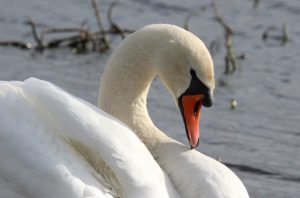 Whether you see them on lochs, rivers or on the sea, mute swans are impressive and, always, regal looking. These qualities, plus their almost sparkling like white plumage and behaviour, have made them the subject of many poets, writers, composers, artists and photographers. Over the centuries this has made the mute swan the subject of many myths and legends that could compete with any other bird. Even the name is a misnomer as whilst “mute” may indicate it is a silent bird it is the most vocal of the swans. Ironically the word “swan” in itself means “sounder” as if indicating the bird is very vocal or makes a sound. In fact the mute swan will give a deep hiss in anger and will also give a trumpeting grunt and it growls. The sounder part refers to the magical quality of the birds strange and beautiful sound of the wings in flight that is referred to as “soughing”. You cannot hear the sound of the wings in the flight of the whooper swan or the bewicks swan which makes it even more mysterious. Even the origin of mute swans in the UK is intriguing as many people believe they are all descended from feral birds from swans that were kept for food.
Whether you see them on lochs, rivers or on the sea, mute swans are impressive and, always, regal looking. These qualities, plus their almost sparkling like white plumage and behaviour, have made them the subject of many poets, writers, composers, artists and photographers. Over the centuries this has made the mute swan the subject of many myths and legends that could compete with any other bird. Even the name is a misnomer as whilst “mute” may indicate it is a silent bird it is the most vocal of the swans. Ironically the word “swan” in itself means “sounder” as if indicating the bird is very vocal or makes a sound. In fact the mute swan will give a deep hiss in anger and will also give a trumpeting grunt and it growls. The sounder part refers to the magical quality of the birds strange and beautiful sound of the wings in flight that is referred to as “soughing”. You cannot hear the sound of the wings in the flight of the whooper swan or the bewicks swan which makes it even more mysterious. Even the origin of mute swans in the UK is intriguing as many people believe they are all descended from feral birds from swans that were kept for food.
This is the critical time of the year for the mute swans as the breeding season is well under way and the birds are already incubating their eggs as their season starts really early. One local nest I looked at last week near Dochfour had the female, she is called a pen, sitting so tight on the huge nest she was fast asleep. The nest was about a metre high and would have had a raised hollow at the centre. The nest was about two or three metres across at the base so was a massive structure. The male, called the cob, would have started the nest but would later have been joined by the female. The 5 to 7 eggs are huge at 115 mm x 74 mm ( about six inches by three inches). When I looked at the loch the male was away on the open water and was literally on guard. He will take turns at incubating but only for very short periods. Once the cygnets have hatched they stay in the nest for a day or two and then leave but all the time are protected by both parents. The cygnets feed themselves but the adult female will pull up aquatic plants for them. I took the photograph of the cob with his characteristic large black knob at the base of the upper beak and it shows how graceful the bird can be.
It may seem to us that with such a large bird that they have no problems over predators etc. but this is far from case. One danger is the ingestion of lead shot over areas where shooting is commonplace. The swans think the shot is grit but it can be fatal to them. Foxes have been known to swim out to an island where the swans nest but the last barrier is the thickness of the eggs which can foil them. Oil spillage can affect the plumage and overhead cables can be a disaster in some areas. There is also an element of needless vandalism from people. In a few areas around Inverness there are large pike in the lochs and these can cause problems by eating small cygnets. 0ne common habit of the pen is to carry the young cygnets around on her back which foils the fish.
Tags: highland birds
